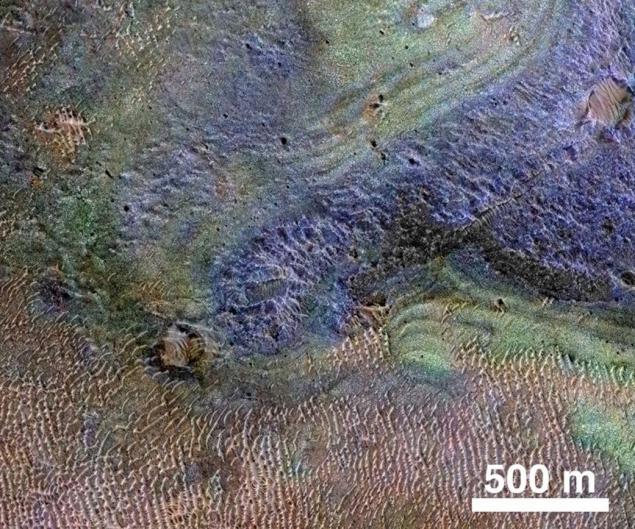694
Mars was hardly warm and humid - the results of NASA research

Mine Nili Fossae (Credits: NASA / JPL-Caltech / JHUAPL / Univ. of Arizona) i>
Researchers may, приблизились to solving a rather complicated problem - the reconstruction of the process of climate change Mars for billions of years, with the gradual transformation of Mars in the Red Planet, which we see now. The results of analysis of samples of carbonate rocks of Mars suggest that the planet's atmosphere would lose much of the carbon dioxide before being on Mars sfomirovalas network of valleys and rivers.
The concentration of carbon in the carbonate sediments of Mars is now twice higher than in the current Martian atmosphere. Nevertheless, even if we unite all the known reserves of carbon, this is still not enough for the formation of the dense atmosphere, which, according to some modern theories that existed at the time when the river flowed on Mars.
Carbon dioxide - the main component of the Martian atmosphere. This gas may be vented to the atmosphere and is isolated, or the chemical reactions associated with the formation of carbonate rocks. Long before the implementation of a series of successful Mars missions, scientists believed that the carbonate sediments of Mars is linked much of the original atmosphere of the planet's carbon. But further research is carried out in the course of missions, have shown that the majority of deposits of rocks on Mars contain a small amount of carbon, and only some fat may be called "concentrated". At the moment, the biggest deposit of carbonates is a region called Nili Fossae. The total area of the field around the wound area of Arizona.
Study concerning the study of carbonate deposits of Mars and the carbon concentration in the respective breeds, conducted by scientists Christopher Edwards (US Geological Survey) and Bethany Elman (California Institute of Technology and the NASA Jet Propulsion Laboratory). The results of his work he published in the famous journal Geology. Studies conducted using a variety of instruments on Mars orbiters. The scientists compared the current concentration of carbon in the carbonate sediments of Mars with the theoretical index, which should be relevant to the atmosphere of early Mars, which would be dense enough to sustain liquid water on the planet's surface. Scientists estimate that in this case, on Mars there must be about 35 fields that are equal in size Nili Fossae. However, so far scientists have not been able to find the required number of fields in the study of data to send to Earth the different spacecraft.
Scientists also argue that even if the atmosphere of Mars was indeed much denser than it is now, most of it was lost at the time of the formation of a network of valleys and rivers. At this time, the atmosphere was still dense enough to sustain liquid water, but warm this era can not be called. Most likely, most of Mars was covered not lakes and ice, with occasional snowfalls the rain. And with a little raise the temperature of the ice melted, followed by the appearance of large amounts of liquid water, forming a valley. After a while it all over again would freeze.
So it may well be that Mars was never warm and wet at the same time.
Source: geektimes.ru/post/261964/
New pictures of the lives of ordinary citizens of North Korea
Like the sound it reveals what can not be seen























